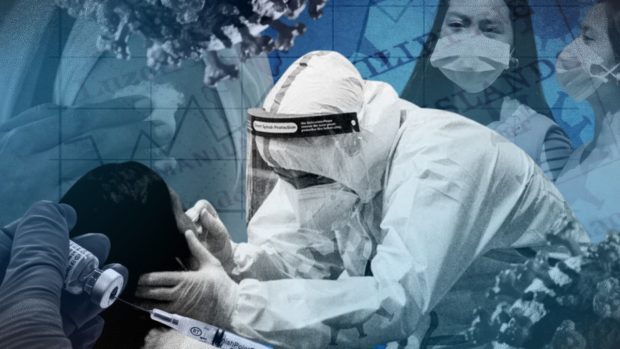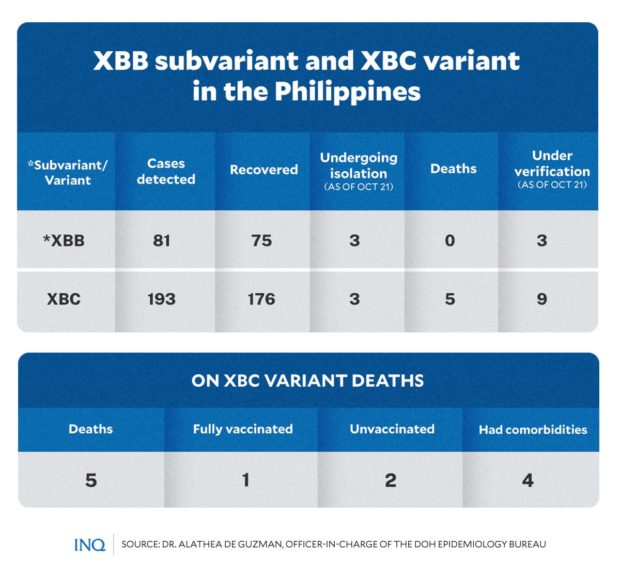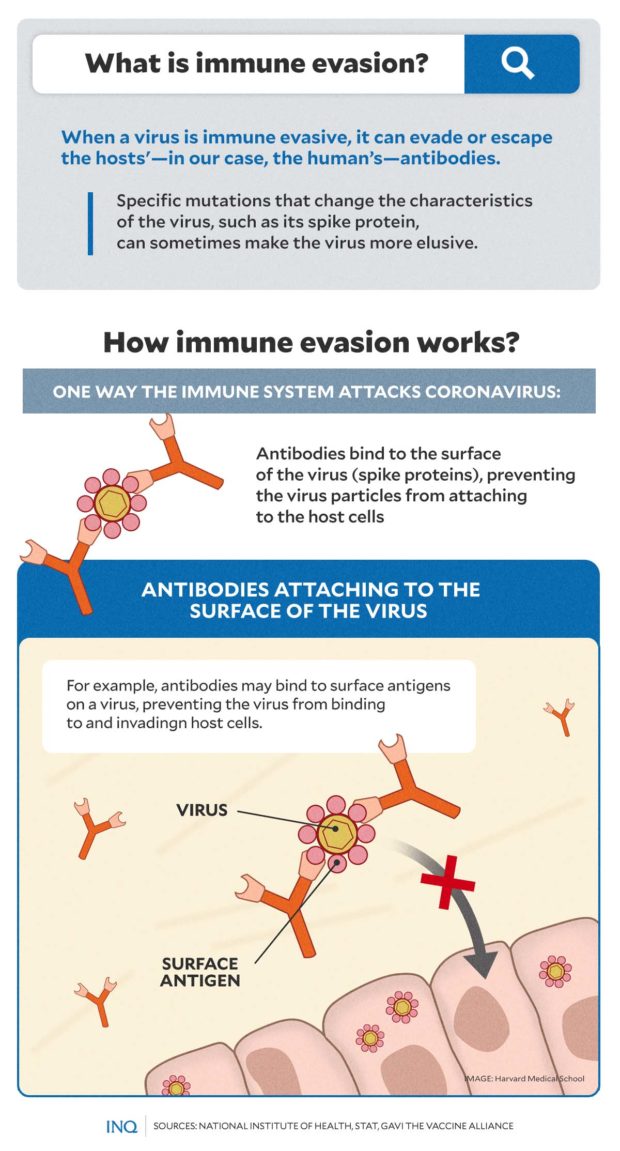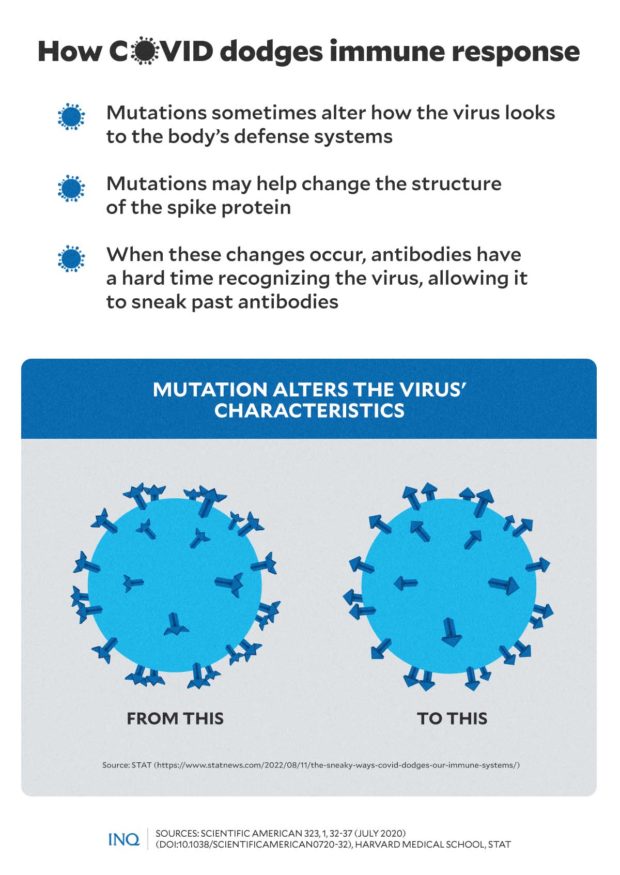As PH prepares to drop masks, new COVID versions show prowess vs immunity
MANILA, Philippines—Newer Omicron sub-variant XBB and coronavirus variant XBC, both of which have already reached the Philippines, had been described by experts as “immune-evasive.”
What does it mean?
Last week, when the Department of Health (DOH) confirmed that newly-emerged Omicron XBB sub-variant and XBC variant have been detected in the country, these were described as highly-immune evasive.
READ: Philippines detects 81 COVID-19 cases of new XBB Omicron subvariant – DOH
Several pre-print and peer-reviewed studies published in various scientific journals this year also used the same descriptor as characteristics of the new variant and Omicron sub-variant.
But what does this tell us about the virus’ newest versions? Does this mean that XBB and XBC would be more dangerous than the previous variants and sub-variants of SARS-CoV2?
In this article, INQURER.net will try to explain what “immune-evasive” means, how a variant or sub-variant becomes better at evading immunity, and how the country’s health experts see this development.
Learning the coronavirus vocabulary
Before examining how immune evasion works and affects a virus, we should first dissect the meaning behind the terms commonly used to describe the coronavirus, particularly the COVID-19 variants and sub-variants—from “mutation” to “immune escape.”
- Mutation: According to the US Centers for Disease Control and Prevention (CDC), mutation refers to a single change in the virus’s genetic code or genome. Mutation happens frequently and is a normal part of viral replication. This occurs when a mistake is made during replication, but in rare instances, mutations change the virus’s behavior.
- Spike protein: This refers to the protruding spikes or bumps seen on the surface of the SARS-CoV-2 virus. Spike proteins, which helps the virus gain entry into healthy cells, are the target of antibodies released by the body’s immune system—the body’s defense against infections.
- Variant: A virus is considered a variant with a slightly different genetic sequence due to one or more mutations.
- Immune evasion (also called immune escape): When a virus is immune evasive, it can evade or escape the hosts’—in our case, the human’s—antibodies. Specific mutations that change the characteristics of the virus, such as its spike protein, can sometimes make the virus more elusive.
At an online town hall meeting last week, epidemiologist John Wong said the Omicron XBB sub-variant has “higher immune evasion against transmission” compared to the previous BA.5 sub-variant.
However, he stressed that there had been no sufficient evidence yet that proves it causes more severe illness compared to the original Omicron variant.
“We have to remember when we talk about immune evasion, there are several levels: immune evasion against transmission, against severe disease, or death,” Wong added.
Further studies are still needed to characterize the XBC variant in terms of its transmissibility, effect on disease severity, and ability to escape the immune response.
Dodging immune system: How it works
Earlier this year, a Danish study found that the Omicron variant is better at evading immunity than previous COVID variants. Omicron’s immune evasiveness, the scientists said, causes the variant to become more transmissible.
READ: Omicron evades immunity better than Delta, Danish study finds
Months after this first discovery, recent studies discovered that newer versions of Omicron also could evade the immune system—with some papers pointing out how emerging sub-variants become better at escaping the body’s immune response.
READ: New versions of Omicron are masters of immune evasion
“As you get more and more immune individuals, the effect of transmissibility is not just infecting human cells better. It’s dodging antibodies better,” virologist Jeremy Kamil, an associate professor of microbiology and immunology at Louisiana State University Health Shreveport, explained in an interview.
Studies have shown that mutation plays a crucial role in how new coronavirus variants and Omicron sub-variants gain the ability to evade antibodies or the immune response.
In a paper published online, scientists Hanzhong Ke, Matthew Chang, and Wayne Marasco, of the US-based Dana-Farber Cancer Institute, explained that since the SARS-CoV-2 virus emerged, it has been evolving or mutating to “escape the ‘walls’ built by vaccination, previous infection, and their combinations.”
These walls are also known as the body’s immune response against the virus.
“Additionally, the Omicron variant continues to break through adaptive immune responses by the development of further sub-variants,” the scientists said in their study published in the National Library of Medicine.
“With an established spectrum of mutations, the Omicron sub-variants are able to evade previous immunity and antiviral measurements, including therapeutic monoclonal antibodies, while rendering the current vaccines less effective,” they added.
READ: Immune Evasion of SARS-COV-2 Omicron Subvariants
Antibodies—a Y-shaped protective protein produced by our body’s immune system in response to a foreign substance (such as bacteria or virus)—attach to the surface of the spike proteins of the coronavirus.
By doing so, antibodies prevent the coronavirus from attaching and invading host cells—thus preventing COVID-19 infection.
READ: How the body reacts to viruses
However, SARS-CoV-2 effectively uses techniques to escape the immune system.
According to virologist Suresh V. Kuchipudi—clinical professor and chair of Emerging Infectious Diseases at Penn State University—these escape strategies “range from changing the shape of key proteins recognized by your immune system’s protective antibodies to camouflaging its genetic material to fool human cells into considering it a part of themselves instead of an invader to attack.”
While in most cases, mutations harm the virus—or do not do anything at all—rare instances showed that the process could alter how the virus hooks to our defense system. As described in a report published in STAT, it is like giving plastic surgery to the spike protein.
With a new appearance or composition, the antibodies have a hard time recognizing the virus—allowing the virus to sneak past the antibodies and infect people.
“In addition to these immune-evading mutations, SARS-CoV-2 has been evolving to suppress its hosts’—in this case, humans’—innate immunity,” Kuchipudi said.
“Innate immunity is the body’s first line of defense against invading pathogens, comprised of antiviral proteins that help fight viruses. SARS-CoV-2 has the ability to suppress the activation of some of these key antiviral proteins, meaning it’s able to effectively get past many of the body’s defenses,” Kuchipudi added.
“This explains the spread of infections among vaccinated or previously infected people.”
READ: How the Omicron Subvariant BA.5 BEcame a Master of Disguise – and What It Means for the Current COVID-19 Surge
As SARS-CoV-2 and the Omicron variant keep evolving, emerging variants or subvariants will continue to outcompete their predecessors.
XBB, XBC in PH
On October 21, Alathea de Guzman, officer-in-charge of the DOH Epidemiology Bureau, announced that there is already local transmission of the Omicron sub-variant XBB and the XBC variant in the country.
READ: DOH reports local transmission of Omicron XBB subvariant, XBC variant
At an online town hall meeting, De Guzman said that the DOH recorded 81 cases of the XBB variant. Of those cases, 75 were tagged as recovered, 3 were undergoing isolation, while the status of the remaining 3 cases were still being verified.
A total of 193 cases of the XBC sub-variant were detected across 11 regions in the country. At least 176 cases were categorized by the DOH as recovered, 3 were still undergoing isolation, 5 died, while the outcome of the remaining 9 were under verification.
De Guzman also explained that compared to the previous COVID-19 variants and their sub-variants—Alpha, Beta, Delta—the number of severe and critical cases and fatality rate of the emerging variants remained low.
“We can see that the proportion of severe and critical [cases] for these new emerging variants like BA.5, XBB, and XBC are lower [or] almost half of the severe and critical cases for Omicron,” she said in Filipino.
“Of course, these numbers will change, especially the [figures for] severe, critical, and fatality rates of those emerging variants, as we foresee that we will be detecting more of these in the next few weeks or months as we continue our disease surveillance and genomic surveillance,” she added.
Data presented by De Guzman showed that from July 14 to September 12, a total of 124 severe and critical cases of Omicron sub-variants BA.5 and XBB and XBC variant—out of the total 8,907 sequenced cases—were recorded.
The case fatality rate for the two emerging Omicron sub-variants and the coronavirus variant was 0.28 percent.
What’s next?
Wong said that the health department should continue to monitor the extent of and impact on the transmission of the XBB sub-variant and XBC variant in the country.
While the health care utilization rate (HCUR) remains manageable, he stressed the need for “preparatory activities to ensure proper triage systems and increase availability and access to step-down facilities”—which he said have already been initiated—to prevent excess mortality.
He likewise emphasized that regardless of the variant, the layers of COVID-19 protection—“testing and staying home when sick, improving access to oral antivirals for high-risk individuals, and getting vaccinated and boosted”—remain effective.
“Transmission leads to new variants which are almost always more transmissible. Hence, to prevent the emergence of new variants, we must all work together to mitigate transmission by (1) masking when necessary, (2) improving ventilation, and (3) getting vaccinated and boosted,” he added.
READ: Epidemiologist urges public to continue wearing masks outdoors
TSB
For more news about the novel coronavirus click here.
What you need to know about Coronavirus.
For more information on COVID-19, call the DOH Hotline: (02) 86517800 local 1149/1150.
The Inquirer Foundation supports our healthcare frontliners and is still accepting cash donations to be deposited at Banco de Oro (BDO) current account #007960018860 or donate through PayMaya using this link.



